Pantex Blog
Wild Pantex – Pantex’s Strangest Creature
Article by Jim Ray, Pantex Wildlife Biologist/Scientist
Quite regularly at Pantex, I will get the question, "What is the most unusual thing that you have seen out here?" Or, "What is the most interesting thing that you have seen out here?”
Well, in either case my answer has nothing to do with something that is rare or new to me. In fact, the species is quite common, though not commonly observed because of its tendency to stay in burrows except at night or during rainfall. As a kid in my hometown of Dalhart, I found them living in our water meters.
Allow me to get even more specific.
What I am calling Pantex's strangest creature is a form of the adult barred tiger salamander, which is physically different from the terrestrial form as determined by a "climate of sanctuary" within a harsh environment.
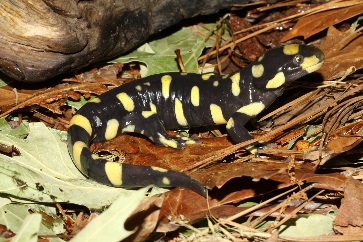
An adult of the terrestrial form of the barred tiger salamander. Photo courtesy of Richard T. Kazmaier.
But, I digress. Let's look at the "conventional" reproduction strategy of our barred tiger salamander. This species lives in burrows in the uplands, and like toads, "migrates" by the dozens, hundreds, or thousands during or after rainfall to reproduce in our playa lakes and other such situations. Depending on water temperature, their eggs hatch in two to five weeks into larvae that have front legs and external gills. Eventually, they "sprout" hind legs, lose their external gills, and then leave the water at three to four months of age. The larvae are often collected and sold as "water dogs" for fish bait.
In June 2010, my West Texas A&M University subcontractor working on amphibians and reptiles encountered approximately 50 terrestrial adults crossing the highway that makes our east boundary. This was following a substantial thunderstorm and each individual was moving east to west, presumably towards a playa wetland located approximately a half mile to the west. That same day, I observed a similar scenario on the highway and in proximity to a playa wetland a few miles to the south.
Here is where the strangeness begins...
In an arid environment, where tiger salamanders have access to a fairly permanent, fish-free body of water, a proportion of their larvae take advantage of the sanctuary of the available water by sexually maturing, while retaining their larval form. This is called neoteny. Besides an advantage to the individual (safety and habitat for reproduction), this benefits the population by allowing for continued production during times that the terrestrial form may not have available surface water and for a duration to accommodate egg-laying and the maturing of larvae.
A proportion of the neotenic population morphs to become cannibalistic. These get huge, develop proportionately larger heads and teeth, and specialize on eating smaller individuals of their own kind. Neotenic tiger salamanders are perfectly capable of reproducing and will mate with each other, or even with their terrestrial counterparts that enter the water to breed. Again, a proportion of the resulting offspring will morph into the terrestrial form, while many will remain in the water in the neotenic form.
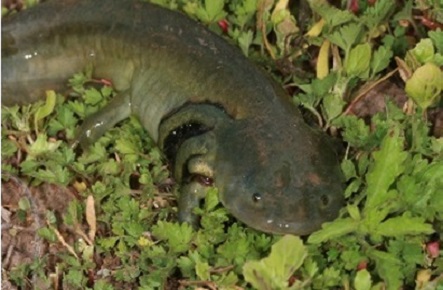
An adult of the neotenic form of the barred tiger salamander. Photo courtesy Richard T. Kazmaier.
Equally interesting; should the neotenic adults become stressed, such as through lowering water levels, many will go ahead and metamorphisize into the terrestrial form and leave the water! Huge individuals will lose a significant amount of mass in the transformation.
So, where at Pantex do we have these interesting neotenic creatures? The answer is our Waste Water Treatment Facility and associated Irrigation Storage Pond, which fit the requirements for neotenic individuals to thrive: reliable, fish-free water source in an arid or semi-arid environment.
Are these guys equipped to survive in an arid environment or what? The tiger salamander is one of my favorite species that inhabits our Wild Pantex.
Pantex SPO receives national honor
Pantex security police officer Billy Hall was recently recognized as one of the best in the U.S. Department of Energy Complex.
Hall is the latest recipient of the Colonel Sydnor Award, named after Colonel Elliot P. Sydnor, who had a large impact in the modernization of the Savannah River Site’s Protective Force in 1983. Sydnor would go on to help develop the Department of Energy’s Composite Adversary Team.
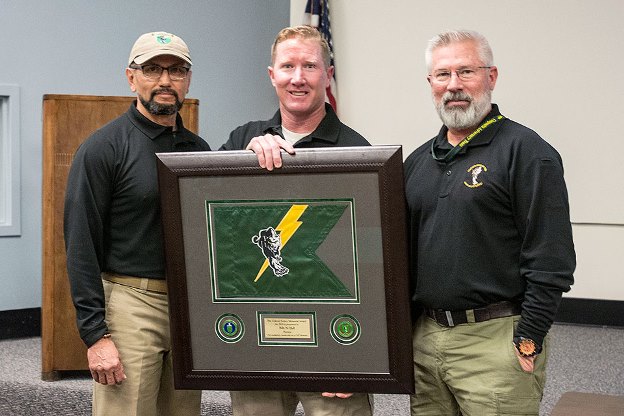
Billy Hall (center) receives the Colonel Sydnor Award from Ben Bitonel (left) and Kerry Wisniewski.
In honor of Colonel Sydnor, the Office of Enterprise Assessments presents the award annually to a CAT member who demonstrates the highest level of physical fitness and tactical proficiency and exhibits qualities associated with superior character and leadership.
“The Composite Adversary Team represents the most talented Security Police Officers across the DOE complex,” Protective Force Deputy Chief Daniel Holmes said. “It is very difficult to be selected to be a part of the CAT program.”
Hall has been a part of the Special Response Team at Pantex for 14 years and is now an SRT captain. He said that the position has given him many tools that have allowed him to be a more effective leader for his team.
“Being selected for this award by my peers — from all of the other DOE sites — as the Colonel Sydnor winner is the greatest accomplishment in my career thus far,” said Hall. “Finally reaching this goal has been very gratifying and required much hard work, patience, dedication and love for what I do.”
The DOE CAT Program’s level of excellence is recognized throughout the worldwide nuclear security community, and Pantex has risen to the occasion before. Hall is the third Pantexan to receive this honor in the last 20 years.
Wild Pantex – Happy to help
Article by Jim Ray, Pantex Wildlife Biologist/Scientist
Occasionally, Pantex staff comes across injured and very young wildlife in need of assistance. This often involves observations and captures by Natural Resources staff while out conducting fieldwork, or observations by Plant employees who are arriving at or departing the Plant, working at various job sites, or just walking between buildings.
My wildest experience with helping an injured animal involved a bobcat kitten that had been hit by a car. Out of concern, a team of Pantex Security Police Officers delivered the youngster to me and, fearing the worst, I delivered it to a local veterinary clinic licensed to care for wildlife. Let’s just say that the excitement centered on watching the veterinary staff trying to hold the kitten down on an x-ray machine in order to assess its injuries. The process involved several people and several repositionings of a not-too-happy feline in order to obtain the needed x-rays. In the end, however, the cat was ruled mostly healthy and able to be reunited with his mother and siblings. Because of our familiarity with the family as part of our research program, I was able to locate the female that evening and watched as the youngster rushed to his mother, who then led it and its three siblings off into the wilds of Pantex.
Although unfortunate that animals sometimes need assistance, Pantex is always happy to get them proper care from a wildlife rehabilitator. Through the years this has included the one bobcat kitten, several bats, and various songbirds such as cliff swallows, various birds-of-prey such as American kestrels, and a cattle egret.
The process starts with an evaluation of the animal’s condition and age. We can generally tell if a young bird is old enough to be out of the nest based on the species and appearance (degree of feathering and health). For example, great horned owl chicks often leave their nest a little earlier than one would expect and phone calls to me can be common despite the owlets being healthy and well fed. This is a well-known problem with deer and pronghorn fawns; where healthy fawns are often picked up by well-meaning folks and delivered to a rehabilitator. The rule of thumb for these cases is that if they are alive and appear healthy, they are being cared for and fed.
Pantex Natural Resources staff maintain a list of rehabilitators that are licensed to be able to possess and care for wildlife by the Texas Parks and Wildlife Department and the U. S. Fish and Wildlife Service. The process for getting animals cared for involves Natural Resources staff capturing or picking up the animal, and then coordinating with and making delivery to a rehabilitator. We always ask that the animal be returned to Pantex for release following rehabilitation.
Our most recent case of a wildlife species needing assistance involved an injured female American kestrel. I had already arrived at home following work, but by phone was able to coordinate the capture of the small falcon and make arrangements with the Wild West Wildlife Rehabilitation Center (Amarillo). The employees who found the kestrel were able to capture and then delivered it to the rehabilitator for care. The kestrel was successfully rehabilitated and then released at Pantex following a few weeks of veterinary care. We owe gratitude to the rehabilitation center for that successful rehabilitation, as we do to the South Plains Wildlife Rehabilitation Center (Lubbock) and associates of theirs in Amarillo, for cases in the past. Pantex is happy to assist wildlife in this manner and considers it a vital component of the wildlife program.
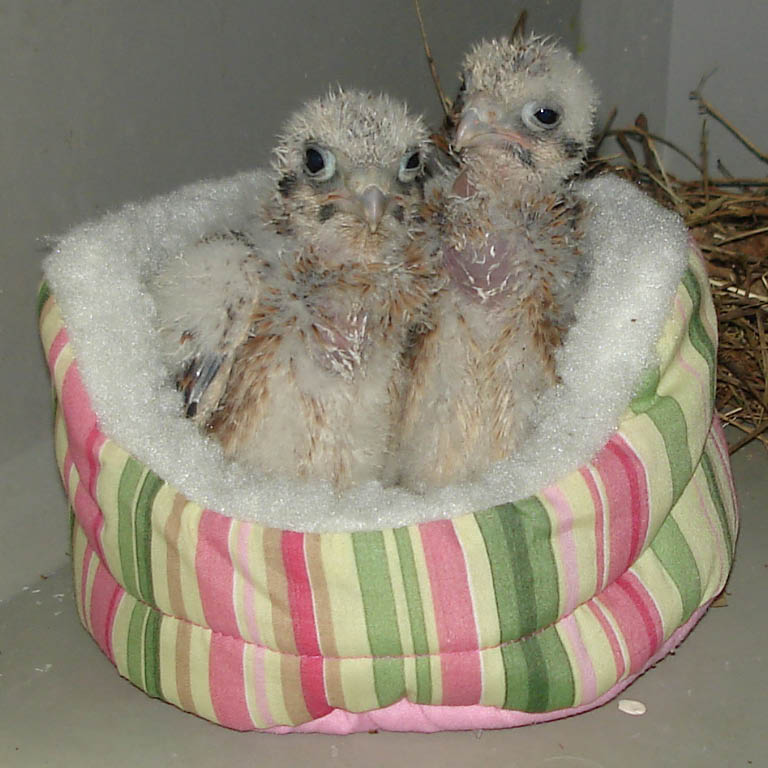
These nestling American kestrels are among a number of wildlife at the USDOE/NNSA Pantex that have received assistance from Pantex staff and licensed rehabilitators over the years.
Historical Pantex: A village is born
In 1943, housing was at a premium in the Amarillo area. With the war effort and production at Pantex already in full swing and a growing workforce, the need for new homes was obvious.
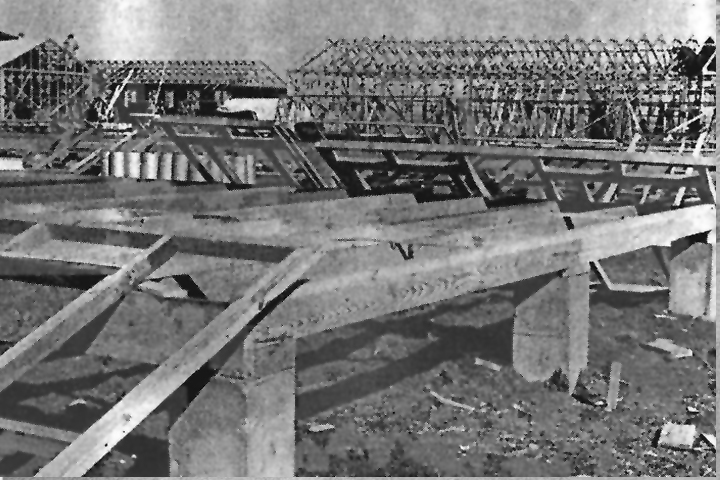
Construction of pre-fab housing units at the Pantex Village.
The National Housing Administration approved 175 new homes to be built in Amarillo for Pantex employees with 3 or more family members, but even that number was not sufficient. So, an additional 360 units were approved including 142 two-room apartments, 128 one-bedroom apartments, 60 two-bedroom units and 30 with three bedrooms.
It was all part of what was then called “Pantex City,” which was located just north of U.S. Highway 60 and Farm-to-Market Road 683. Initially, along with apartment buildings and homes, plans for the city included a shopping center with a grocery store, meat market, fire station, drug store, barber shop, beauty parlor, shoe repair and a tailor shop. There was also talk of a possible grade school with plans to bus students back to town for high school.
Construction was slated for completion in April 1943, thanks to pre-fabricated, mass-production methods. The apartment buildings went up like Tinker Toys with each dwelling having between four to eight apartments. An additional 400 pre-fab homes were soon added, bringing the population of the Pantex Village up to a few thousand. The village grew to 69 residence buildings, a community center and a store to support the approximately 5,325 employees at Pantex working 3 shifts at the height of World War II.
Noted cowboy poet and author Buck Ramsey lived at the village, according to a 1977 article called “Letter from the Panhandle,” which was printed in the Texas Observer magazine. In it, he reminisced about his time at Pantex.
“On the western edge, the government constructed a village; symmetrical rows of buildings so uniform there was a nightly problem of entering the wrong apartment by mistake. The war industry, with its promise of regular paychecks and dwellings with gas heaters and indoor plumbing, lured many families from the hardscrabble countryside. Mine was among them.
“I sometimes slipped through the fences to wander about the forbidden pastures, to lie on my back in the ungrazed grass… and listen to trains rumble away with bombs for Europe and Asia. The war ended with me seven years old. For a couple more years we lived in the village, while the munitions plant deteriorated from the peace. I grew bolder with age and would climb up to survey the area from watchtowers. I walked the barracks porches, and then broke into deserted buildings to steel my nerves against the ghosts inside, preparing myself for some future war.”
Ramsey noted in his writings about the barren countryside and how set apart the village seemed to be from the rest of the area.
In fact, the village was very isolated, functioning as a self-sufficient community. It was 10 miles from the town of Panhandle and accessed only through a perimeter gate that was locked each evening. There were recreational facilities, especially for the younger set, including basketball and tennis courts along with a teen club where dances took place.
To some outsiders, the village was known as the low-income “Cardboard Village” due to the pre-fab materials and walls so thin you could hear neighbors talking.
As a village, there was also a small newspaper called the Pantex Breeze. There were no real village officials because the place was run like a housing project. There was a manager, but no one was ever elected as an official to preside over the village.
After the war, things started to change. In 1949, the plant and village were acquired by Texas Technological College (now Texas Tech University) in Lubbock, and, by the end of that year, the village was turned over to Carson County.
The village was still going strong in the early 1950s. According to housing advertisements in the Pantexan magazine, the rent for a one- to three-bedroom apartment ranged from $33 to $42 per month, with all utilities paid.
In 1968, Pantex Village closed due to the large number of vacancies caused by improved economic opportunities elsewhere and the closing of the Amarillo Air Base in 1967.
Eventually, ads were placed throughout the Panhandle that the buildings were all to be sold at auction. Some of the smaller buildings are reportedly still being used in the town of Panhandle as a storage shed and another as a re-bricked building. Today, all that’s left as a reminder of the early days of the facility and the role it played at the Pantex Plant are a few concrete slabs dotted around the area where the village once stood.
However, the most surprising remnant of the auction is right down Interstate 40 as you enter Amarillo. On the east side of town, you will find one of the most advertised and well visited tourist destinations, the Big Texan Steak Restaurant, famous for its “free 72-ounce steak, if eaten within an hour.”
Bob Lee purchased and dismantled five barracks picked up at the auction and used the lumber to build his restaurant in 1960. Reportedly, most of that wood was lost in a fire in 1976, but the restaurant was rebuilt with the help of 100 of his employees pitching in.
Just like a time more than 30 years earlier… it took a village.
Smart Play
With nearly three-fourths of the workforce at the Pantex Plant only five years away from retirement age, Consolidated Nuclear Security (CNS) has put a heavy focus cultivating our future workforce.
Data from the U.S. Bureau of Labor Statistics (BLS) states that employment in occupations related to STEM – science, technology, engineering, and mathematics – is projected to grow to more than 9 million between 2012 to 2022. Something that we know first-hand.
In 2015, CNS donated $10,000 to Bushland Independent School District (BISD) to help them kick-start an initiative to create a hands-on, high-tech STEM educational program.
The district knew there was a need to provide more STEM-related education. They decided that the best direction to implement this initiative was to form elementary, middle, and high school teams that would participate in FIRST® (For Inspiration and Recognition of Science and Technology), international robotics competitions that drive students to research and explore real-world scientific and engineering challenges.
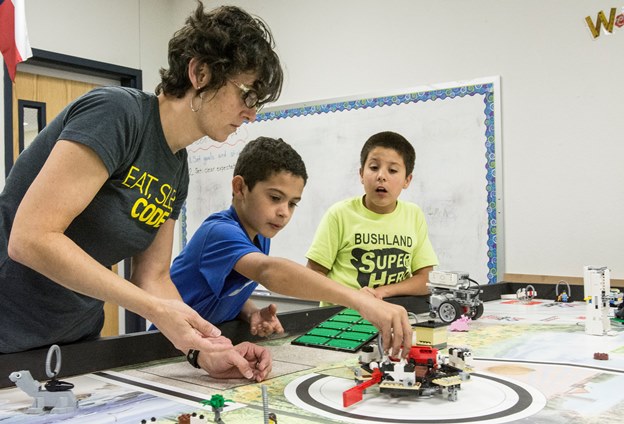
The teachers responsible for building this multi-level robotics program agreed upon a plan that no one saw coming. The popular choice would have been to use the funds to immediately support the high school STEM program, but the teachers chose to take a different approach. One that would build a solid foundation for STEM education for years to come.
“Just like in sports. You don’t wait until high school to start building athletes,” said BISD teacher and robotics sponsor, Jessica Patterson. “The same is true for education. You don’t wait until college to build engineers.”
Jessica Patterson, who runs Bushland Elementary’s Einstein Lab, along with Melissa Cochran, who handles the computer lab, and Christina Butler, who teaches special education, have other daily responsibilities but were willing to devote nights and weekends to cultivate a program that would enhance students’ learning to the next level.
After hosting a “Get to Know Robotics Family Night,” students organized teams to create their own robot and research presentation. By May 2015, BISD had 11 FIRST LEGO® League Jr. (JrFLL) teams, seven FIRST LEGO League (FLL) teams, and one FIRST Tech Challenge (FTC) team. The question now was: How can we serve more than 100 students without sending every one of them to Dallas to compete in a tournament?
Thus began the TexPan Robotics tournament. BISD staff, in conjunction with Amarillo College Engineering Society and Amarillo Area Center for Advanced Learning (AACAL), created a robotics tournament to serve all local teams.
“We saw the need for all students in the Texas Panhandle to have a local tournament to compete and celebrate learning,” said Patterson.
Currently, TexPan robotics is working with FIRST to become an official region for students in the panhandle. The 2015 tournament champions were The Purple Perspicacious Pandas, a group of six middle school girls who defeated their competitors to receive an ACE (Advancing to Championship) certificate allowing them to travel to Dallas to compete in the North Texas FLL Regional Championship in February 2016.
After tournament season ended, the Bushland Robotics teachers (otherwise known as the LEGO Ladies) devised a plan to rollout a “WE Do STEM” and EV3 robotics academy. The “WeDo STEM” academy serves students in kindergarten through second grade, and EV3 academy serves third through eighth grade. This six-week robotics academy was held outside of normal school hours and began teaching the basic skills of building and programing a robot. Later, academies addressed programming sensors and precision programming.
“We chose to keep to six-week learning programs because the short learning process engages kids to learn rather than just show up for a club meeting,” explained Patterson.
The academy was full within a matter of minutes of registration opening, showing the teachers that there was obviously an interest by the students and it was backed by their parents. The spring academies sparked such an interest in the students and their parents, that BISD now has seen a growth in teams to 11 JrFLL, 10 FLL, and two FTC teams. An outside interest has added two additional FLL teams from the local homeschool community and from the Boy Scout council.
“Without the donation from Pantex, this program would not have been possible,” said Patterson. “The students’ learning is so rapid that we are moving faster than we could have imagined and these resources provided by Pantex are an essential part to our success.”
Pantex provided BISD with another $10,000 contribution for the 2016–2017 school year in an effort for them to expand their program to the FTC for 7–12 grade students and eventually a FIRST Robotics Challenge team for 10–12 grade students.
